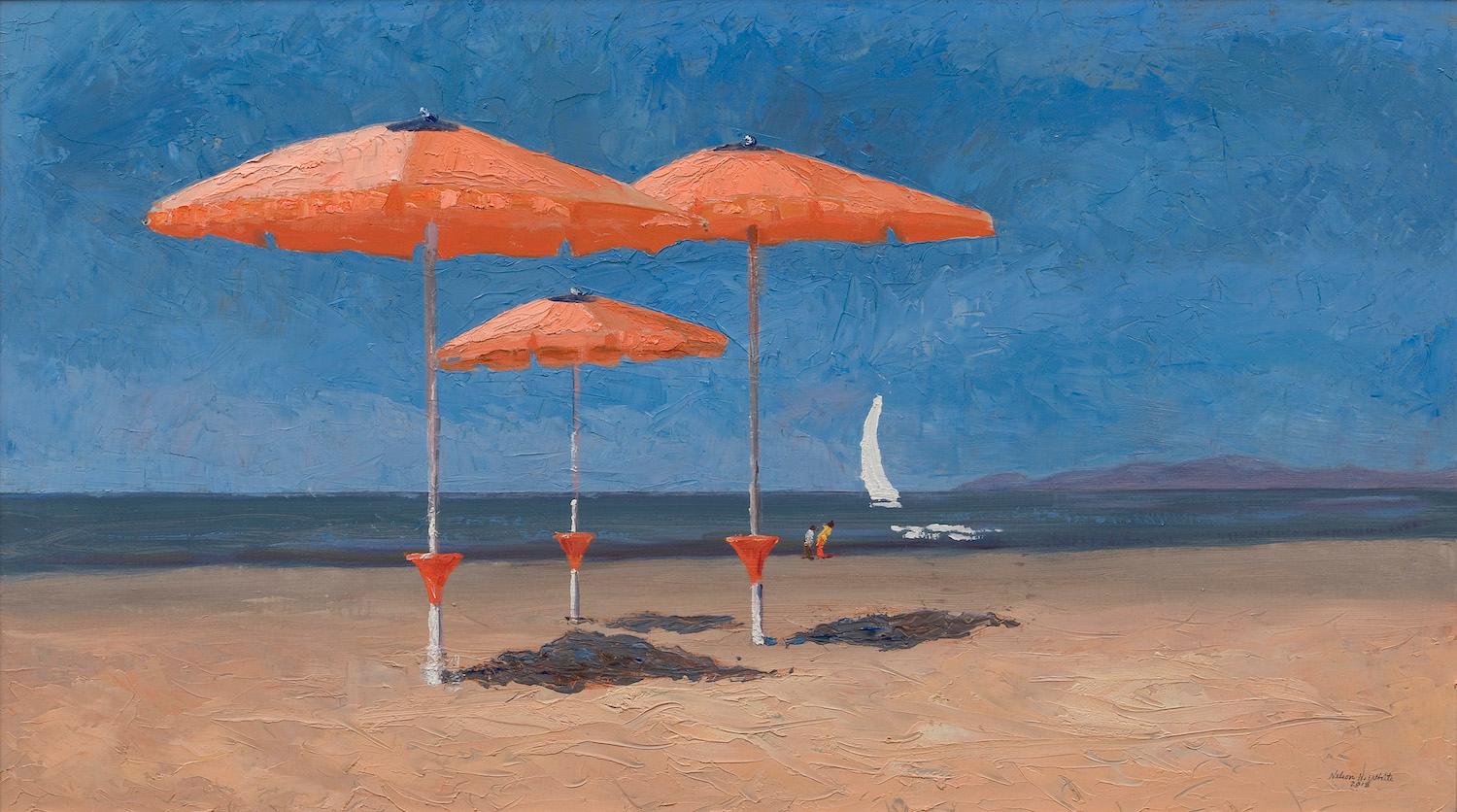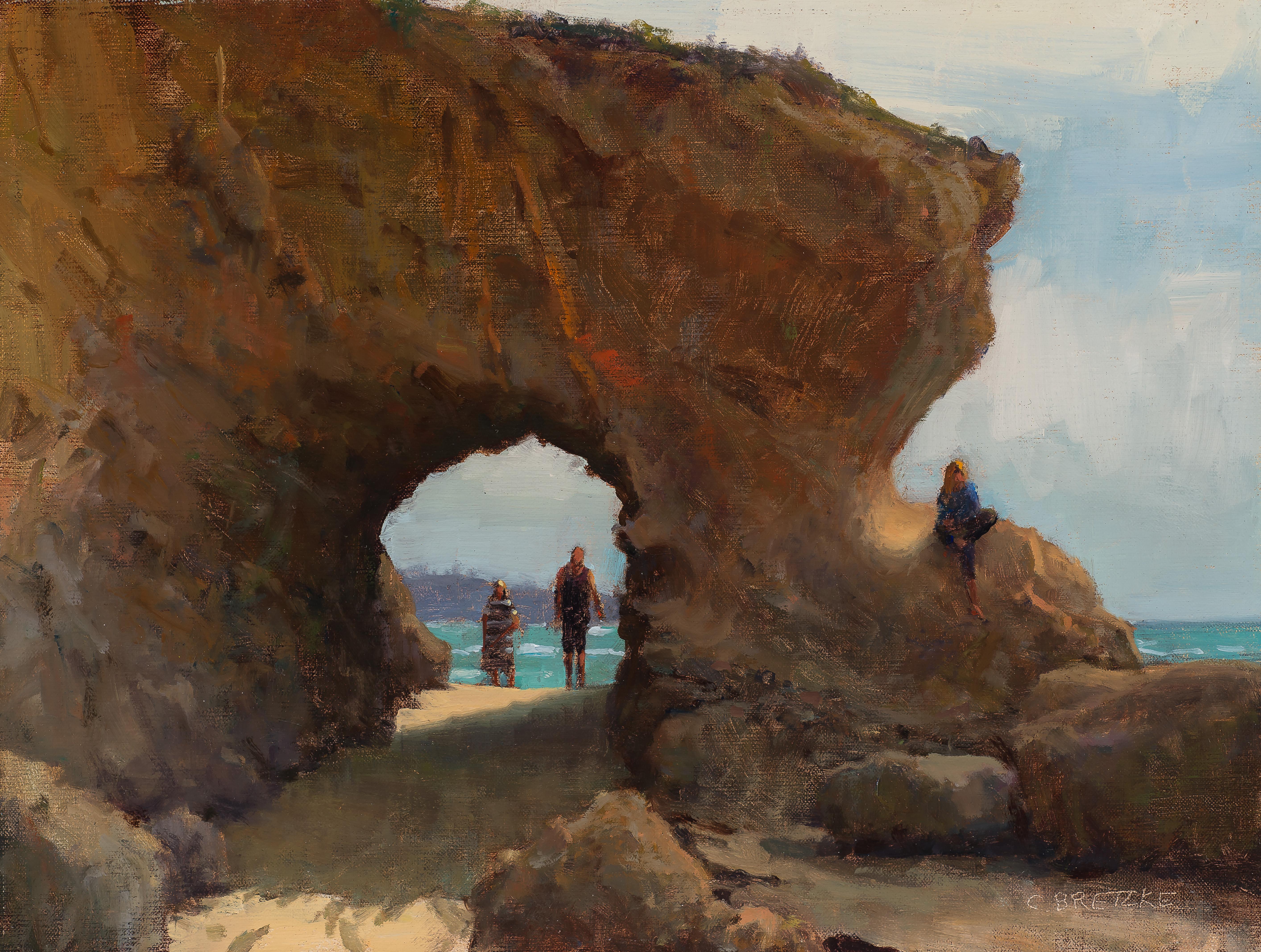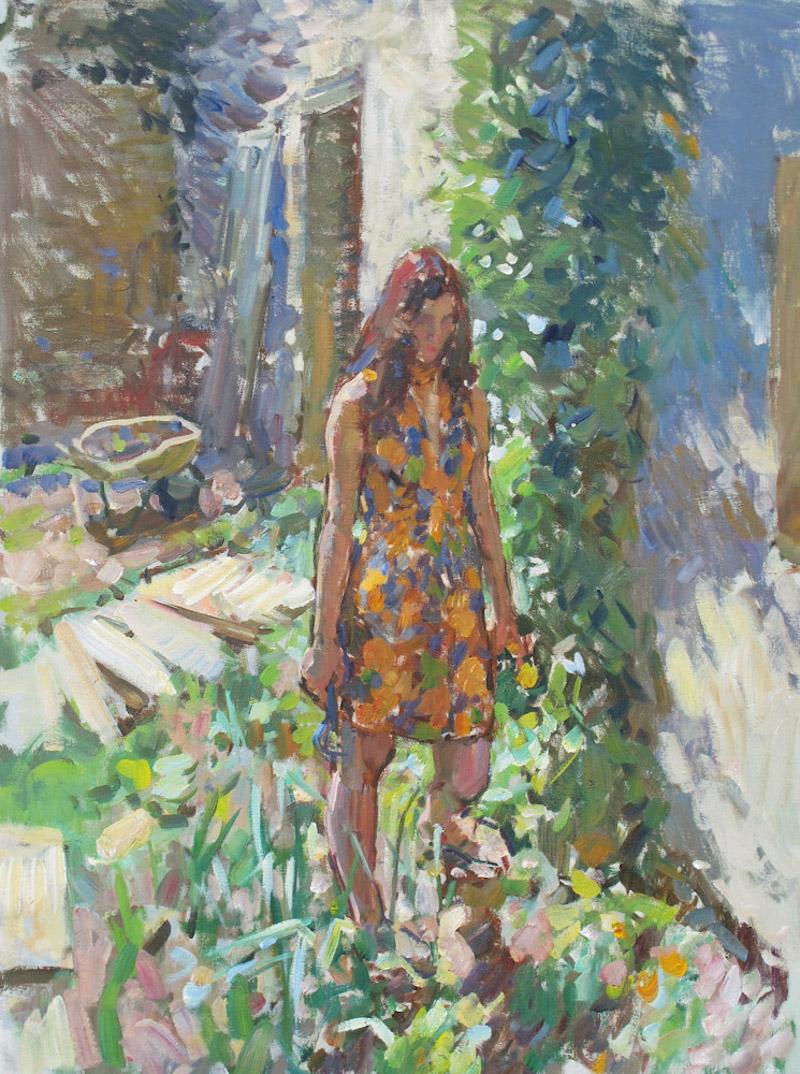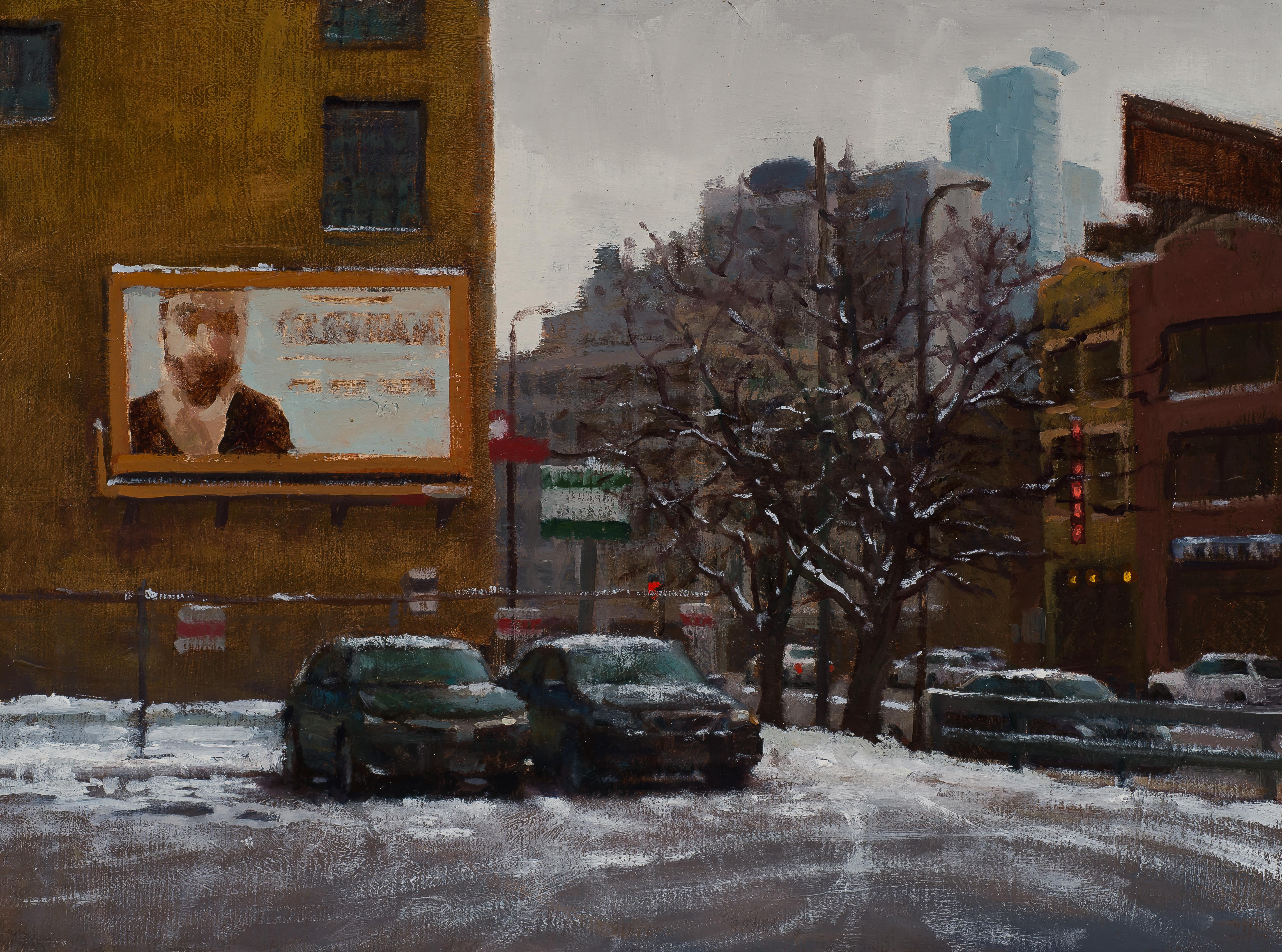Items Similar to Early 20th Century California Landscape - Sunrise On Tin Mountain, Death Valley
Want more images or videos?
Request additional images or videos from the seller
1 of 13
Edward LangleyEarly 20th Century California Landscape - Sunrise On Tin Mountain, Death Valley1913
1913
About the Item
Gorgeous California landscape titled, "Sunrise on Tin Mountain, Death Valley" with Oak in foreground and mountains and Eucalyptus trees in background by Edward Langley (American, 1870 - 1949), 1929. Impasto brushwork adds interest and depth. Signed and dated lower right corner and signed/titled on verso. Condition: Good; professionally cleaned and restored; one tear repaired (see images). Presented in rustic period frame of gilt-toned patinated framed. Image size is 23"H x 28"W.
Edward Langley born in London, England on March 27, 1870. When quite young Langley was abandoned by his parents in Australia. Making his way to Canada, he traveled alone by canoe down to the Gulf of Mexico. In Chicago he worked with Wm Selig in developing the motion picture camera and became a U.S. citizen in 1904. Before that he had played trumpet in the Illinois State Guard for many years. Sometime before 1917 he came to Hollywood, CA with Selig where they produced the pioneer epic, 'The Spoilers." A few years later Langley became art director for the Fairbanks Studio on such films as "Thief of Bagdad," "Three Musketeers," and "Mark of Zorro." From 1921 until 1934 the Langley home in Los Angeles was a gathering place for artists and the film colony. Close Friends with Mary Pickford and Douglas Fairbanks. When not busy with the movies, he was active in the local art scene. As a lecturer at local women's clubs, he used his paintings and special lighting effects to show the moods of the desert. Langley was painting in Japan when war erupted and was a prisoner there until 1943. Returning to California, he lived in Salinas, Laguna, and La Jolla where he taught painting classes. He died in Los Angeles on May 11, 1949, Langley is best known for his southern California desertscapes. Exhibition: Painters & Sculptors of LA, 1926; Mission Inn (Riverside), 1927; Bullocks (LA), 1929 (solo); Ebell Club (LA), 1920s. In: Desert Hot Springs (CA) Museum; Nevada Museum (Reno). PF; lnvw; CA&A; CD; SCA; DR.
From an article in Riverside Daily Press, Jan. 2, 1928, p. 6.
Edward Langley was a painter of desert scenes, who was active with Atascadero Studios, 1917 and other studios in Hollywood in the 1920s and 1930s. “Choosing as his topic, ‘The Evolution of the Motion Picture,’ Edward Langley, technical director of the Fairbanks-Pickford studio, will lecture at 7:30 o’clock tonight in the Little Theatre. ‘The first enemy of the motion picture,’ said Langley recently in an interview, ‘was the saloon. The innovation of the motion picture, as an amusement, gave many a new diversion and drew them away from the saloons.’ Langley, who has been with the Fairbanks production company for more than seven years, confesses that his hobby is neither golf nor tennis, but sketching and painting. Painting the California desert and studying its moods is his chief delight. … Langley may be considered as an important figure in the world of art. He sings and plays the cello, is writing a book on motion picture work, and lectures frequently aside from his work as technical director. At present the artist has 250 sketches, drawings, engravings, and water colorings on exhibition at the Chamber of Commerce in Los Angeles. He is a member of the Painters and Sculptors Club of California and a member of the Board of Governors of Artland, an artists’ club of Los Angeles. Research Attractive. ‘One of the beauties of a technical director’s work is the vast amount of research necessary to gather information as a background for the production of any picture. Before we began filming ‘The Three Musketeers’ I read thirteen histories of France in order to understand the character of the people, their mannerisms, how they ate and drank, the size of the buildings during that era, and other similar things about the period. ‘I think I have read all the pirate stories ever written,’ declared Langley in speaking of the preliminary work on ‘The Black Pirate,’ which is now playing in San Francisco and is the first complete picture produced in Technicolor photography. Langley, who is a pioneer in the motion picture industry, started in the field of photography before the introduction of the motion picture which was first begun in 1901. For about six years previous to that time, the director was concerned with the production of slides and pictures. Slides Once Used. In outlining the history of the slides, Langley remarked: ‘When we wanted to put on in a small town, an entertainment with slides, we secured a store, whitewashed its back wall, arranged some chairs in the room, and hung out a big sign in front of the store. There was no attempt made to have the slides tell a continuous story except as one slide would represent a man being chased up a tree by a dog with the succeeding slide showing him falling out of the tree. ‘The large sum of five cents was charged each person who came to the entertainment. The whole show lasted only about thirty minutes.’ Begins with ‘The Spoilers’. Fifteen or sixteen years ago, Edward Langley came to the Pacific Coast as technical director of ‘The Spoilers,’ the first big picture ever produced on the Pacific Coast. He was a member of the art staff producing the Jack London series and was concerned with several other ventures in the motion picture industry before becoming an art director for Douglas Fairbanks. ‘We call them Doug and Mary,’ said Langley, when asked about Mr. and Mrs. Fairbanks. ‘Mary is one of the sweetest girls I have ever known. She is full of joy and happiness and Doug is full of pep, always playing a prank on us or showing us a new trick. ‘I believe the success of the Fairbanks studio results from the co-operation of the film stars and their staff of workers.’ All the high schools in San Francisco are to hear Edward Langley lecture on the motion picture. This morning he spoke before the San Francisco Polytechnic school and will address the other student bodies during the next two weeks,” per The Daily Palo Alto, Stanford University, April 13, 1926, pp. 1, 4 (on the Internet). “Langley Paintings Displayed at Inn… Mission Inn… One of the most delightful features of his work is his ability to interpret music in oil. Included in the exhibit… are several musical moods, or tone-poems as he calls them. One, suggested by Mendelssohn’s Spring Song, is a lovely dream in green, its trees and lake and flowers veiled by the mist of imagination. His interpretation of a Schumann prelude suggests the cathedral through its handling of a forest glade. Light and airy as the French court of Louis XIII waltz. A picture of Cadman’s ‘Canoe Song’ is interesting. In direct contrast to these pictures, which might almost be termed spiritual, so ethereal are they, are the pictures of the desert. Mr. Langley excels in his portrayal of the brassy heat of the desert.… Sunset moods.… Scenes in and around Death Valley, where Mr. Langley spent some weeks with his friend, ‘Death Valley’ Scotty, recently, show a Dore quality… handling of the chasms and valleys of the region… Mr. Langley is a versatile man. He paints. He writes. He plays the cello. He has sung in opera. He is now art director for Douglas Fairbanks, and has worked in the art field of motion pictures for 29 years. His wife is a pianist of distinction, and their small daughter is a dancer…,” Riverside Daily Press, Jan. 2, 1928, p. 6.
Prior to shipping, our resident Art Conservator will inspect the piece and if necessary clean, remove any old, yellowed varnish, repair blemishes and minor issues and put on coat of UV-resistant varnish to insure against future tonal depreciation.
- Creator:Edward Langley (American)
- Creation Year:1913
- Dimensions:Height: 26.5 in (67.31 cm)Width: 32 in (81.28 cm)Depth: 2 in (5.08 cm)
- Medium:
- Movement & Style:
- Period:
- Condition:Very good. Professionally cleaned and restored; one tear repaired (see images). Frames are included “as is,” but as a courtesy, minor cosmetic issues will be retouched as necessary prior to shipping.
- Gallery Location:Soquel, CA
- Reference Number:
About the Seller
4.9
Platinum Seller
These expertly vetted sellers are 1stDibs' most experienced sellers and are rated highest by our customers.
Established in 1986
1stDibs seller since 2014
2,535 sales on 1stDibs
Typical response time: <1 hour
- ShippingRetrieving quote...Ships From: Soquel, CA
- Return PolicyA return for this item may be initiated within 14 days of delivery.
More From This SellerView All
- Early 20th Century Landscape -- Tree on the GreenLocated in Soquel, CAVerdant 1920's landscape of trees looking out towards Rockaway Beach, NY, in the style of but not attributed to Jane Peterson (American, 20th Century). ...Category
Early 20th Century American Impressionist Landscape Paintings
MaterialsLinen, Masonite, Oil
- Summer Seas, Mid-Century Asilomar California Seascape 1943By William Clothier WattsLocated in Soquel, CASummer Seas, Mid-Century Asilomar California Seascape by William Clothier Watts A beautiful and substantial mid-century seascape by William Clo...Category
1940s American Impressionist Landscape Paintings
MaterialsOil, Linen
- Early 20th Century California Sand Dunes LandscapeBy Rowena R. SmithLocated in Soquel, CABeautiful California landscape painting of a path to the beach by listed Berkeley, California artist Rowena R. Smith (American, 1881-195...Category
1930s American Impressionist Landscape Paintings
MaterialsLinen, Oil
- Late 19th Century Yosemite, El Capitan with Mill LandscapeBy R.B. ProllLocated in Soquel, CAMoody late 19th century Yosemite, California landscape of an old mill with the El Capitan Heights and the Three Brothers receding into the mist by R.B. Proll (American, 19th Century)...Category
Late 19th Century American Impressionist Landscape Paintings
MaterialsLinen, Oil
- The Warning - Mid Century Western Cowboy Figurative LandscapeBy Charles CochraneLocated in Soquel, CAWestern figurative landscape of a cowboy with two horses surrounded by desert scenery by Charles Cochrane (American, 1923-1990), 1966. Signed "Cochrane" lower right. Displayed in a rustic giltwood frame. Image size: 22"H x 27.5"W. In the Gold Rush days a visitor could be a friend or foe, which is the theme of this excellent example of Charles Cochrane's western style. Charles L. Cochrane was born in the hills of Missouri on January 29, 1923. During World War Two "Chuck" Cochrane served in the First Marine Parachute Regiment...Category
1960s American Impressionist Figurative Paintings
MaterialsOil, Linen
- 1880s Figurative Sackett's Calvary Charge of the 9th New York VolunteersLocated in Soquel, CALate 19th century figurative painting of the battle of Trevilians Station and of the wounding of Colonel Sackett June 11, 1864. Oil on canvas in giltwood frame. Signed or notated indistinctly lower right. Image, 20.25"H x 36.25"W. Military History Prior to 1865 The 9th New York Cavalry contained two companies from Cattaraugus County. It was mustered into the service October 1, 1861 and, until mustered out in July, 1865, lost 619 officers and men out of a total enlistment of a little less than two thousand. It participated in many battles and skirmishes and lost its colonel, William Sackett, who was killed at Trevilian Station, Virginia, on June 11, 1864. From the Albany Evening Journal, July 20, 1864: Another name is added to the list of hero martyrs who have fallen in the service of their country. Col. WILLIAM SACKETT, of the Ninth New-York Cavalry, (son of Hon. W.A. SACKETT,) was mortally wounded in the engagement, under Gen. SHERIDAN, at Pavillion Station, Va., and died on the 14th ult. As he was left behind, the sad intelligence of his decease has but just been received. Col. SACKETT had seen much service. He entered the army on the 22d of April, 1861, was appointed Major of the Ninth New-York Cavalry in October of the same year, was promoted to Lieutenant-Colonelcy in August, 1862, and in March, 1863, became commander of the regiment. He was with Gen. MCCLEELAN in the Peninsula campaign, was in all the cavalry actions of the campaign which followed, was with the army in its advance after the battle of Antietam, and in almost constant conflict with the enemy until after the battle of Fredericksburgh. He participated in most of the cavalry engagements under Gen. HOOKER's command, was in all the principal cavalry actions during LEE's invasion of Maryland and Pennsylvania in 1863, and was among the first engaged in the terrible conflict at Gettysburgh, where he performed distinguished service in holding a rebel brigade in check a long time while our forces were getting into position on the crest of the hill. He was active in the cavalry skirmishes which ensued in the latter part of the Summer. During the present campaign he was with Gen. SHERIDAN in all his brilliant expeditions up to the time when he fell. He died while leading a charge against the enemies of his country -- died, as he wished to die, doing his whole duty. He was brave, he was generous, he was unflinchingly faithful to the cause of the Union. He loved the old flag with a love that was stronger than life, and esteemed it glorious to fall in its defense. He was born in Seneca Falls, and was 25 years of age. When the great civil war broke out [William Sackett] was practicing law at Albany, N. Y., having a short time previous been admitted to the bar. In December, 1861, he was commissioned Major of the 9th Regiment of New York Cavalry, and taking the field served with credit in several engagements in which that command participated. On June 27, 1862, his immediate superior, Lieutenant- Colonel Hyde, resigned and three days later Major Sackett was commissioned to fill the vacancy. On the 30th of the following May he was advanced to the Colonelcy of his regiment, with rank from March 15, 1863. It is stated in "Battles and Leaders of the Civil War" that the cavalry pickets commanded by Colonel Sackett fired the first shot at the battle of Gettysburg. He subsequently led his command, in a gallant manner, in numerous engagements, including the battle of Trevilians Station, fought June 10, 1864. There he received a mortal wound and died inside of the enemy's lines some three days later. The report that he had been severely wounded and was in the hands of the enemy soon reached his wife, who immediately determined to make an effort to reach and care for him, not knowing that he was already dead when the report reached her. The following correspondence, copied from Official Records published by the War Department, tells in most emphatic terms of her devotion. City Point, Va., July 7, 1864. General R. E. Lee, Commanding Confederate Army, Mrs. Sackett, the wife of Colonel William Sackett, who was wounded on the 11th of June, near Trevilians Station, Va., is here in deep distress and feeling great anxiety to learn the fate of her husband. Colonel Sackett was left at a house some two miles and a half from the station, in charge of...Category
1880s American Impressionist Figurative Paintings
MaterialsOil, Linen
You May Also Like
- Bagno La SaluteBy Nelson WhiteLocated in Sag Harbor, NYPainted en plein air on the coast of Italy, in Viareggio. A beach landscape with orange umbrellas, a sailboat catches wind along the horizon. Painted with thick oil paint in the styl...Category
21st Century and Contemporary American Impressionist Landscape Paintings
MaterialsOil, Linen
- PerchedBy Carl BretzkeLocated in Sag Harbor, NYOil painting of a beach in California Artist Bio Carl Bretzke is a representational painter who specializes in urban scenes and plein-air landscapes. Carl's work has been exhibited...Category
2010s American Impressionist Landscape Paintings
MaterialsOil, Linen
- Metro SupperclubBy Carl BretzkeLocated in Sag Harbor, NYOil painting of a bustling Florida street at night. Carl Bretzke cheekily renames the street "C. Bretzke Av" in his rendition of the scene. A bright squiggle of blue neon light ribbo...Category
2010s American Impressionist Landscape Paintings
MaterialsLinen, Oil
- Bea, GardenBy Ben FenskeLocated in Sag Harbor, NYA contemporary oil painting of a woman standing in a garden. Wearing a printed orange dress, she almost blends into the colorful landscape which surrounds her. Tall wild grass sits i...Category
21st Century and Contemporary American Impressionist Landscape Paintings
MaterialsLinen, Oil
- Two Cars and a BillboardBy Carl BretzkeLocated in Sag Harbor, NYOil painting of cars in front of a billboard, painted en plein air, in Minneapolis, MN during the winter. Artist Bio Carl Bretzke is a representation...Category
2010s American Impressionist Landscape Paintings
MaterialsOil, Linen
- Looking For ShadeBy Carl BretzkeLocated in Sag Harbor, NYOil painting of a beach in Laguna, California. Artist Bio Carl Bretzke is a representational painter who specializes in urban scenes and plein-air landscapes. Carl's work has been...Category
2010s American Impressionist Landscape Paintings
MaterialsOil, Linen
Recently Viewed
View AllMore Ways To Browse
Antique Death
Old California Art
Yellow Art Late 20th Century
American Drew Chairs
Edward Mayer
Mountain Women
Motion Picture
Japanese Landscape Antique
Antique American High Chairs
American Chair Company Antique
Dance Of Death
Oil On Tin
Japanese Mountain Landscape
Antique Tin Art
Antique Tin Paint
Small Tin
Nevada California
Antique Camera Art





